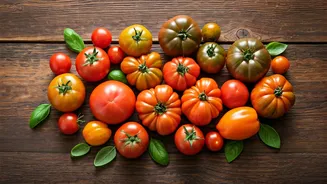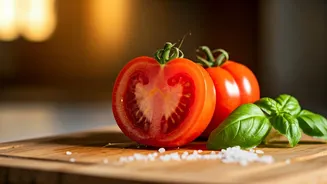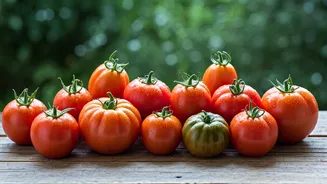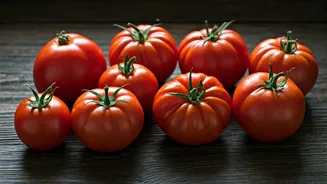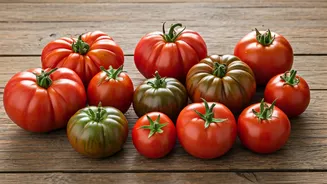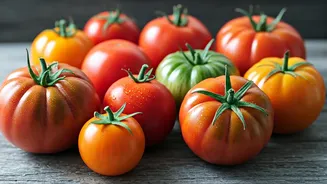Italian Tomato Delight
Beginning our gastronomic journey, we find ourselves in Italy with the classic pasta sauce. The Italians, masters of simplicity, know the key to unlocking
the tomato's essence: fresh tomatoes, garlic, olive oil, and basil. This foundation of flavors creates a sauce that is both light and intensely flavorful, coating the pasta perfectly. The beauty of the Italian preparation lies in its versatility. It serves as a base for many other dishes, easily adaptable for different tastes. A hint of chili flakes can add warmth, or a generous sprinkle of Parmesan cheese contributes a salty, rich finish. No matter how it's customized, the dish reflects Italy's culinary traditions and simplicity.
Spanish Gazpacho’s Chill
Next, we head to Spain, where the summer heat is tempered by gazpacho. This chilled soup showcases tomatoes in their most refreshing form. The tomatoes, combined with cucumbers, peppers, onions, and garlic, are blended into a smooth and refreshing consistency. The key to the authenticity of gazpacho lies in using the freshest, ripest ingredients. Variations on this theme exist throughout Spain, with some regions incorporating sherry vinegar for a touch of acidity and others adding bread for a thicker texture. The soup is typically served cold, often garnished with diced vegetables, a drizzle of olive oil, and a sprinkle of croutons for added texture.
Moroccan Tomato Tagine
Traveling eastward, we encounter the Moroccan tagine, a slow-cooked stew bursting with exotic spices. The tagine starts with a base of tomatoes, often combined with meat (such as lamb or chicken) or vegetables. These are infused with aromatic spices like cumin, coriander, and turmeric. Sweetness is added via dried fruits like apricots or dates. The slow cooking process tenderizes the ingredients and allows the flavors to meld. The tagine is often served with couscous or crusty bread, perfect for soaking up the flavorful sauce. It exemplifies Moroccan culinary traditions, showcasing a combination of savory, sweet, and aromatic components.
Mexican Salsa’s Zing
Then, we go to Mexico where salsa shines. This vibrant condiment is a celebration of fresh flavors. The basic salsa is often prepared by mixing tomatoes, onions, cilantro, jalapenos, and lime juice. Its simplicity belies its powerful taste. Different types of salsa exist, from the chunky pico de gallo to the smoky salsa roja made with roasted tomatoes. Salsa is an important part of Mexican cuisine, served with tacos, tostadas, or simply enjoyed with tortilla chips. The level of spiciness can be adjusted to individual preferences, which makes salsa flexible and accessible to all.
Indian Tomato Curry
Moving to India, we discover tomato curry. Indian tomato curry is a versatile dish, with tomato as its base, along with spices such as ginger, garlic, turmeric, and cumin. It can incorporate vegetables, lentils, or meat. The method of preparation varies across regions. Some curries are mild and creamy with the addition of coconut milk or cream, while others are spicier and more complex. Each variation tells the story of India's regional diversity and uses local ingredients. It is normally served with rice or flatbread, such as roti or naan, making it a filling and flavorful meal.
Turkish Menemen’s Simplicity
Venturing to Turkey, we savor menemen, a savory breakfast dish. Menemen combines tomatoes, peppers, onions, and eggs, scrambled together until the eggs are cooked and the flavors combine. The dish is quick and easy to make, making it a suitable choice for a quick breakfast or lunch. It's often seasoned with red pepper flakes, black pepper, and herbs. The simplicity of menemen makes it a favorite among Turks, a quick and satisfying meal that can be eaten with bread to soak up the flavorful sauce.
French Ratatouille’s Elegance
In France, we encounter ratatouille, a vegetable stew that is both elegant and rustic. It features tomatoes, along with eggplant, zucchini, bell peppers, onions, and garlic, all cooked slowly in olive oil until tender. The beauty of ratatouille is that it lets each vegetable retain its flavor. Herbs such as thyme and bay leaves contribute fragrance and complexity. It can be served as a side dish, a main course, or even as a topping for bread. Ratatouille reflects French culinary practices, highlighting fresh ingredients and simplicity in a tasty, balanced dish.
Thai Tom Yum’s Fusion
Moving to Thailand, we sample tom yum soup. This flavorful soup is a rich combination of tomatoes, lemongrass, galangal, kaffir lime leaves, chilies, and often seafood or chicken. The flavors are a vibrant combination of sour, sweet, salty, and spicy. The soup is an emblem of Thai cuisine. It’s both satisfying and rejuvenating, providing a true taste of Thai culinary traditions, often garnished with fresh cilantro and a squeeze of lime to enhance the taste and visual appeal.
Greek Tomato Salad
In Greece, we savor the simplicity of the Greek tomato salad. This dish is usually prepared with ripe tomatoes, cucumbers, red onions, feta cheese, and olives, dressed with olive oil and a sprinkle of oregano. The taste of fresh ingredients is amplified by the olive oil, allowing the salad's taste to shine. The Greek tomato salad is refreshing and light, ideal for a warm summer day. It is more than a side dish, it's a testament to the way Greeks celebrate fresh, seasonal ingredients in its purest form.
American Tomato Soup
Finally, we end up in America, with the classic tomato soup. American tomato soup, often served with grilled cheese, is a simple comfort food. It usually starts with a base of tomatoes, onions, and sometimes carrots, blended until smooth and creamy. The soup is frequently seasoned with herbs like basil or thyme, adding a depth of flavor. Whether made from scratch or from a can, tomato soup is a versatile and comforting meal that suits all ages and can be customized with various toppings and ingredients to suit individual preferences.
